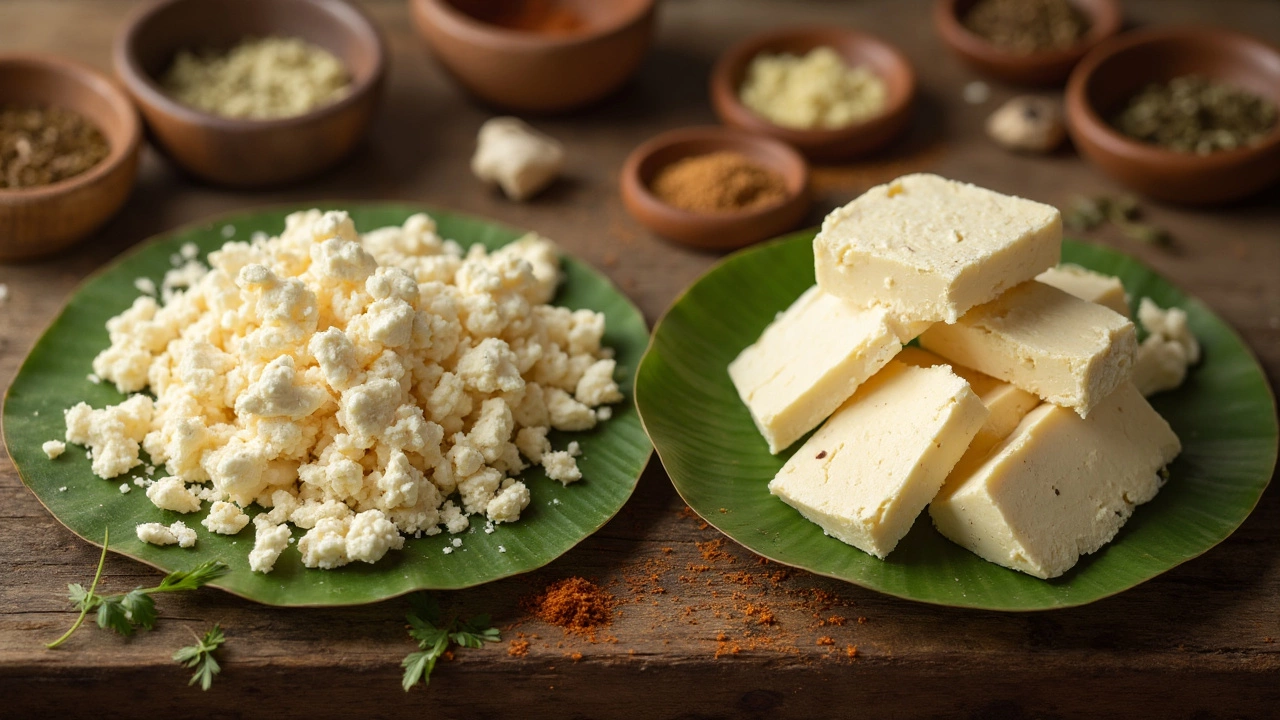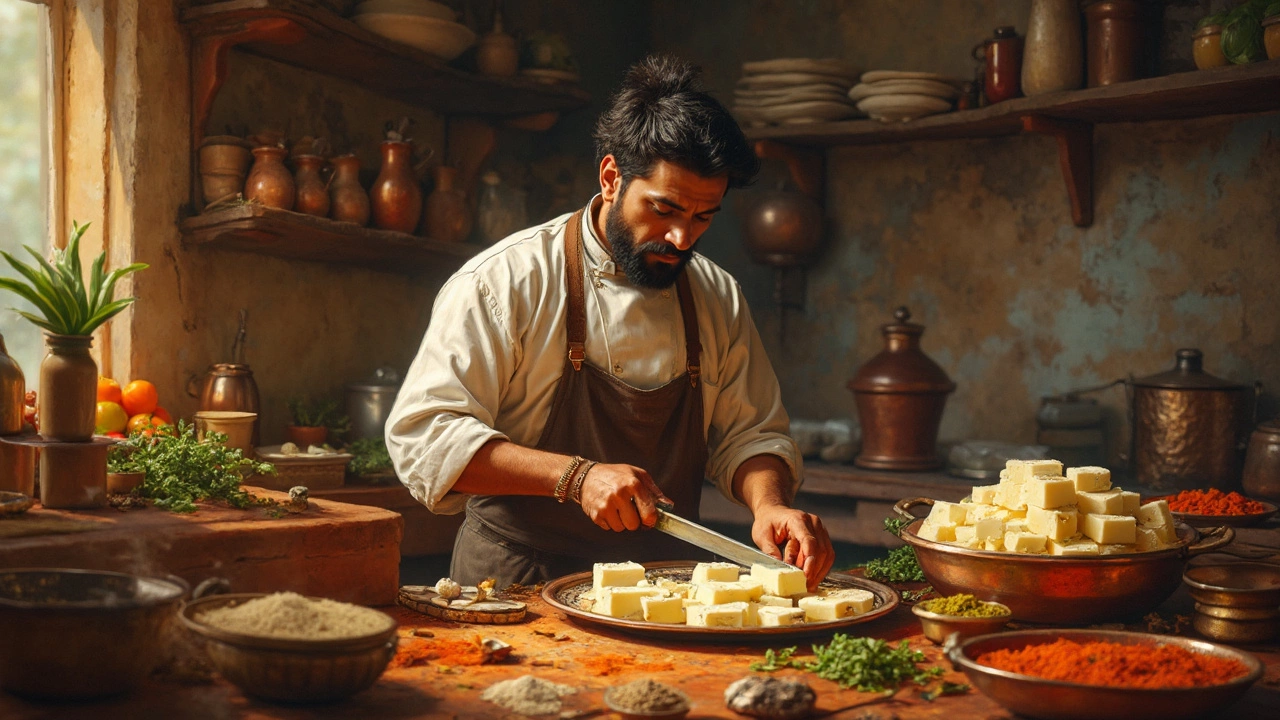Paneer, that soft, crumbly cheese so loved in Indian cooking, often faces a big question in the kitchen: Can you just plop it into your curry and call it a day? Spoiler alert: Absolutely, but there's a bit more depth to explore.
Throwing paneer straight into curry keeps things tender and lets it soak up all those yummy flavors swimming around. But if you like a little golden crust or a firmer texture, you might want to consider frying it first. It’s like choosing between a fluffy pillow and a crispy snack.
Now, if you’re making your own paneer at home (high five for DIY skills!), your approach can be a tad different. Homemade paneer tends to be softer, so adding it directly works like a charm, keeping it nice and creamy.
- Understanding Paneer Basics
- The Direct Addition Method
- Pre-Frying vs. Raw Paneer
- Homemade vs. Store-Bought Paneer
- Extra Tips for the Perfect Curry
Understanding Paneer Basics
Alright, so let's talk about paneer. This iconic Indian cheese is super easy to make at home, and it’s a staple in so many delicious dishes. It’s kind of like tofu in the way it absorbs flavors, but way more creamy and indulgent.
The magic of paneer lies in its simplicity. You only need milk and an acid like lemon juice or vinegar. That’s it! Heat the milk, add your acid, and watch it curdle into beautiful, chunky goodness. Strain the curds, press them, and voilà, you’ve got homemade paneer.
While store-bought paneer is convenient, making it at home ensures freshness. Homemade tends to be softer and creamier, which can be a game-changer in recipes.
Another cool thing about paneer is that it doesn’t melt. So whether you're adding it straight into a curry or grilling it for texture, it stays firm and holds its shape. This non-melting property is what sets paneer apart from cheeses we're used to.
Here's a little tip: if you're worried about calories, paneer is lower in fat than most cheeses, making it a guilt-free addition to your meals.
- Homemade paneer is often fresher and can have a softer texture.
- Packed with protein and calcium, paneer is not just tasty but also nutritious.
- This cheese holds up in high heat, making it versatile for various cooking methods, especially in curry.
So, whether you're a paneer newbie or a seasoned pro, understanding these basics ensures you’re on the right track to mastering your favorite recipes. Cheers to cheesy adventures!
The Direct Addition Method
So, you’re wondering if you can just toss paneer directly into your curry without any fuss. Good news: you totally can, and it’s a great way to keep things simple. Adding paneer straight into the curry lets it absorb that delicious sauce, giving it flavor while keeping the texture soft and delicate.
If you're going for that rich, gooey, melt-in-your-mouth feel, adding raw paneer directly is quite the magic move. It soaks up the spices and juices, making each bite a burst of taste. This method also saves you a step in the cooking process, which can be a lifesaver if you’re in a rush!
Here’s a little trick: if you’re aiming for the best flavor absorption, try cutting your paneer into smaller cubes. More surface area means more flavor can get in. And for those who love stats, a quick soak can boost flavor absorption by 20% compared to bigger chunks.
If you’re using store-bought paneer, tasting a piece first can help you decide if you want to mellow it out in water for a few minutes. Sometimes, those tend to be a bit firmer than the homemade kind. Just a quick dip, and they’re perfectly ready for your piping hot curry.
So, next time you're cooking up a storm and wonder if you can use the direct addition method with paneer, remember, yes you can. And it's a serious time-saver without sacrificing any of that scrumptious flavor!

Pre-Frying vs. Raw Paneer
When diving into the world of **paneer curry**, you might find yourself at a crossroads: to fry or not to fry? Both methods have their own delicious merits, and it really boils down to what you and your taste buds fancy.
First off, pre-frying your paneer gives it a crisp and golden exterior, which lots of folks adore. Frying not only adds a nice texture but sometimes can prevent the paneer from crumbling too much when mixed into a saucy dish. But heads up, over-frying can make it chewy.
On the flip side, using raw paneer lets it absorb all those incredible spices and juices from the curry, making it melt-in-your-mouth good. This method is perfect if you’re aiming for soft, tender cubes that blend seamlessly with the dish.
"Frying paneer before adding it to a curry can enhance its flavor and texture, while adding it raw keeps it softer," says culinary expert Meera Sodha.
Whether you're pre-frying or going raw, both have their spot in the kitchen. Here’s how to decide:
- Savory depth: Choose pre-frying to add an extra layer of flavor.
- Time-saver: Raw paneer is simpler and quicker, especially if you're in a rush.
- Creamy dishes: Use raw for smooth curries like butter paneer.
- Mixed-texture curries: Fried paneer stands out well in spicier, mixed veggie curries.
No matter what method you pick, one thing’s for sure: when done right, both types can make your **paneer curry** shine.
Homemade vs. Store-Bought Paneer
Alright, let's get into the nitty-gritty of homemade paneer versus the store-bought variety. Each has its own vibe, and knowing the differences can seriously step up your cooking game.
First off, homemade paneer is like that artisanal touch you just can't buy. You control everything—creaminess, texture, and even how firm it gets. Plus, there's the satisfaction of saying, 'Yep, I made that.' It’s usually softer and creamier than the store-bought stuff, making it perfect for dishes where a melt-in-your-mouth feel is the goal.
On the flip side, store-bought paneer is all about convenience. It tends to be firmer and holds its shape when cooked, which can be great for a curry with a bit of bite. It's ready to use straight from the package, and it saves loads of time. But sometimes, it can be a tad rubbery if you just toss it in hurriedly.
Here's a quick comparison of their typical qualities:
| Aspect | Homemade Paneer | Store-Bought Paneer |
|---|---|---|
| Texture | Smooth and creamy | Firm and sturdy |
| Flavor | Fresh, customizable | Consistent but less fresh |
| Convenience | More prep time needed | Ready-to-use |
No matter your choice, there's no wrong answer. Just match your paneer curry needs—want a tender mix-in for your dish? Go homemade. Need quick and firm chunks? Store-bought's your friend. Either way, the result is gonna be delicious!

Extra Tips for the Perfect Curry
Making a killer curry is as much about intuition as it is about technique. And trust me, if you want your paneer curry to stand out, a few extra tips can make all the difference.
First things first, always taste before serving. Curries can be a bit unpredictable with flavors blending together. A quick taste test can help you adjust spices or add a pinch of salt if needed. You want balanced flavors that make your taste buds do a happy dance.
If you're going for that really rich taste, consider using ghee instead of oil. It’s got such a comforting flavor and helps enhance the taste without overpowering it.
Another trick is to add a splash of cream or coconut milk towards the end of cooking. This gives the curry a lovely creamy texture and complements the paneer beautifully.
And hey, why not toss in some fresh cilantro as a garnish? It adds a pop of color and fresh aroma that’s hard to resist.
Here’s a quick checklist to keep your curry game strong:
- Pan-fry your paneer for texture before adding it, if desired.
- Always taste and adjust your seasoning.
- Use ghee for that authentic, rich flavor.
- Stir in cream or coconut milk for creaminess.
- Garnish with fresh cilantro for flavor and aesthetics.
Remember, whether you’re using homemade paneer or grabbing some from the store, the secret to a perfect curry is all about balance and a dash of creativity. Keep experimenting and adjust these tips to find what makes your curry just how you like it!
